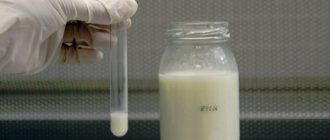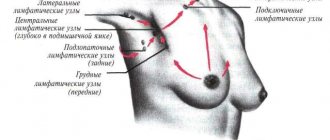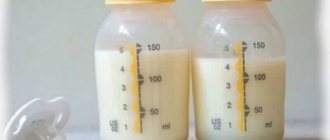Breast milk
The amount of breast milk produced and its composition directly depends on the needs of the child and the environment. Therefore, the older the child, the more food he needs. Accordingly, more breast milk is produced. But when complementary foods appear in the baby’s diet, the volume of milk will decrease. The time of year also plays a role. For example, in summer breast milk is thinner. In winter it becomes more concentrated and nutritious.
- Milk after childbirth, which appears a few days later, is called “mature.” It is produced in greater volumes than colostrum.
- There is a division of breast milk into “front” and “hind”.
- The baby drinks “foremilk” at the beginning of feeding, which is why it is called that. It has a specific bluish color and comes in large quantities. It contains a lot of sugar (lactose) and protein.
- Hind milk, as the name suggests, is what the baby receives at the end of feeding. As a rule, it is white, but can also be yellowish. Unlike “fore milk,” this type of milk is rich in fat. This energizes the baby. Therefore, you should not wean your baby from the breast prematurely. You need to let him suck out all the hind milk. Otherwise, the baby will remain hungry. Interrupted feeding may cause crying.
Foremilk quenches thirst. The “back” allows you to eat.
+
The baby can be overfed with breast milk. But to be honest, you still need to try. Often, this happens if the mother gives him the breast every time the baby gets restless. First, it is better to think about what might be bothering the child and rule out all possible causes. Check the diaper, the temperature in the room (cold/hot), whether there are intestinal colics, or maybe he just wants attention. The main sign that the baby has overeaten is excessive regurgitation after feeding. ⠀
Milk completely quenches thirst. If the baby wants to drink and not eat, then he will drink only “fore milk”. Nature has already thought of everything and there is no need to interfere with natural processes. You can read my article about when to give water to a baby.
One day, I was asked to recommend literature on breastfeeding. It was difficult for me to give an answer, since I use exclusively medical literature, with a certain degree of authority. Most of the information will not be understandable to people who are far from medicine. I try to adapt it for readers and convey it as clearly as possible.
What are the benefits of colostrum?
Colostrum, firstly, is very nutritious, secondly, it is very fatty, and thirdly, it carries elements of immunological protection that the mother passes on to the baby with her breast milk so that he becomes immune. And obvious immunity, which the baby himself will develop to protect against all kinds of microbes, appears only by six months. Therefore, if a mother begins to feed colostrum from the first minutes of the baby’s life and continues until milk comes in, she thereby lays the ideal immune base for the future health of the child. Colostrum is so beneficial that you should never express it.
From the third or fourth day, the young mother begins to feel a surge of milk. This manifests itself in swelling of the mammary glands, painful sensations in the nipples, and often an increase in temperature to 37.5 degrees. During this period, it is very important to closely monitor your breasts and your condition. Too high a temperature, fever, or vice versa - a feeling of cold, too hard breasts - all this indicates that you need to express milk. In addition, with the appearance of milk, breastfeeding becomes the main task of the mother. Of course, a newborn baby is not able to cope with pumping his mother’s breast on his own - he does not need a large amount of milk. That is why doctors recommend expressing milk by hand or using a breast pump after each feeding.
Colostrum and breastfeeding
In the first days after the baby is born, the mammary glands begin to produce thick yellowish milk. It's called colostrum. It contains more immunoglobulins, leukocytes and other protective factors than mature milk. It is especially rich in vitamin A. Colostrum better protects the baby from intense bacterial contamination. Thanks to it, the risk of purulent-septic diseases is reduced. Considering all the benefits of colostrum, it is important that the baby receives it in the first hours of life.
During the first 24 hours, little colostrum is produced. But even its drops are extremely important for a newborn. One drop of it contains as many vital components as 5 ml of mature milk. On the first day, three drops per feeding will be enough for the baby. Mothers who have little colostrum need not worry, your baby will already be full.
- Colostrum has a mild laxative effect. This allows the baby's intestines to be cleared of meconium, and with it bilirubin. This reduces the risk of developing jaundice. This fact contains the answer to the question of whether it is possible to breastfeed a baby with jaundice.
- Colostrum promotes the development and normalization of intestinal functions of the newborn. Protects against allergic reactions in the future, and also reduces the likelihood of food intolerance. Thanks to this yellowish milk, the duration of the physiological dysbiosis phase is reduced.
- Contains growth factors that influence the maturation of intestinal functions.
- Colostrum contains all the necessary nutritional components. They satisfy the needs of a newborn baby until mature milk appears in the mother.
Why is there no milk immediately after birth?
Childbirth is stressful not only for the baby, but also for the female body. The mother needs time to recover, and the newborn needs time to adapt to the new environment. Nature provides that milk remains gradually, changing its composition and volume. Colostrum is released in only a few drops, which contain everything essential for the baby, protecting the baby from infection, as well as restoring it after passing through the birth canal. The mother simply does not have the strength to deal with “milk rivers” after childbirth. After all, even for the appearance of precious drops, the baby is applied to the breast immediately after delivery.
In the first hours, every mother is taught to properly attach the baby to the breast, since correct nipple latching and feeding technique primarily affect further lactation. Even if the mother does not feel colostrum or there is practically no colostrum, the newborn still needs to be fed as often as possible. This will start the lactation process and promote rapid milk production.
Sometimes the milk comes later. For example, if the birth took place by caesarean section. If the operation is prescribed for medical reasons, a threat to life, incorrect positioning of the fetus in the womb or weak labor, then the female body suspends the production of oxytocin, which is responsible for the production of milk. In such cases, lactation consultants advise drinking as much water as possible, sticking to a diet, eating a balanced diet and monitoring a comfortable air temperature around you. You should leave all negative emotions and worries for later, think about the good and take care of your health.
When can colostrum appear?
Many people ask the question: at what time does colostrum appear? There is no clear answer to this question, since in all women it can appear at different stages of pregnancy and the postpartum period.
- From the very beginning of pregnancy. The production of colostrum begins already in the first weeks of pregnancy, but the quantity and intensity of its release is so small that women do not even suspect its presence. In the third trimester of pregnancy, the release of colostrum in most women occurs more intensely, making itself felt in the form of wet underwear.
- After childbirth. As noted above, many women pay attention to colostrum only after childbirth, in other words, when it becomes in demand. Now the appearance of colostrum has become noticeable; it is released daily from the female breast and is intended for the child, namely for feeding it.
- But colostrum is not always a sign of pregnancy! There are cases of so-called inappropriate lactation (galactorrhea). Discharge of fluid from the nipples in the absence of pregnancy is most likely a sign of disease. It is imperative to see a doctor for examination.
I would also like to note in what cases the release of colostrum should cause concern:
- severe pain in the area of the mammary glands and nipple;
- if green colostrum is released from the breast;
- breast discharge has an unpleasant odor;
- colostrum is excreted mixed with blood;
- colostrum is released, but pregnancy has not occurred.
If any alarming signals that raise doubts appear, you should immediately consult a mammologist to rule out the presence of a serious disease. The causes of this dangerous symptom can only be known after an examination.
What kind of milk is there?
1. Colostrum
Colostrum is the first milk found in the breasts of a woman who has given birth. Droplets of colostrum may appear several weeks before or immediately after birth. All this is the norm!
The color of colostrum can range from light yellow to bright orange. It is a fairly thick, viscous liquid. The volume of colostrum is small (from 10 to 100 ml, on average about 30 ml per day), but this is all that the child needs in the first days of life!
Colostrum contains less fat and carbohydrates than mature milk, and more proteins (immune defense factors of a protein nature).
Colostrum contains the highest concentration of immune defense factors (immunoglobulins, leukocytes, etc.) for the entire period of breastfeeding, which significantly protects the child from intense bacterial contamination and reduces the risk of purulent-septic diseases.
The child is born practically sterile. The first hours of a newborn’s life are a critical period when the maximum intensity of colonization of the child’s body by surrounding microorganisms occurs. Colostrum actively protects the newborn, ensuring a balance between the aggressive flora of the environment and the newborn’s immune systems: the protective components of colostrum literally “lining” the walls of the child’s gastrointestinal tract, preventing the spread of pathogenic microflora, protecting the child’s mucous membranes (the main “gate” of infections).—
Thus, colostrum promotes the formation of optimal intestinal microflora, reduces the duration of the physiological dysbiosis phase, and helps the newborn fight pathogens. Contains growth factors that influence the maturation of the child's intestinal functions.
A child receiving colostrum does not need additional feeding. It is this thick and viscous consistency of colostrum that allows the body to properly start the work of the digestive organs and excretory system. At the same time, a child is already born with a supply of water, which protects his body from dehydration until milk rich in liquid arrives and the baby’s body becomes ready to process the increased amount of nutrition.
Colostrum also has a mild laxative effect, which stimulates the passage of meconium and cleanses the baby’s intestines of excess bilirubin, which prevents the development of pathological jaundice.
Myth. Until the milk comes in, you need to feed and supplement the baby. Colostrum is too fatty and there is very little of it. The child is hungry and thirsty.
In fact. Yes, there is little colostrum and it is thicker than milk (not fattier, but thicker). But if a child needed large volumes of fluid immediately after birth, then nature would have designed a woman to fill herself with milk immediately after birth. From the moment of birth, everything the baby needs is obtained from colostrum! The water that is given to the child in the first days literally “washes away” the colostrum from the gastrointestinal tract, depriving the baby of the protective effect of the colostrum components necessary for him. The kidneys of a newborn are not ready for a large load of water and begin to work with overload. This is not a complete list of the dangers fraught with unreasonable supplementation and additional feeding in the first days of life.
2. Transition milk
Transitional milk replaces colostrum on days 3-5. Often, with the appearance of transitional milk, children begin to suckle at the breast much more intensely and latch on more often than in the first days after birth. Milk during this period still remains yellowish and quite thick, but its volume increases sharply.
3. Mature milk
Mature milk replaces transitional milk approximately on the 18-21st day. Compared to colostrum and transitional milk, mature milk looks thinner, “bluish water,” and mothers often worry that the milk has become “bad” and not fat enough for the baby. Although in fact the fat content just increases! 

We automatically compare human milk with cow's milk, which is more familiar to our eyes... But who said that human milk should look the same as the milk of large (or small) cattle? Cow's milk is the best nutrition for a calf, goat's milk is the best for a kid, and human milk is ideal for a human baby.
Naturally, the milk of no other mammal can ensure the optimal development of a newborn of another biological species. For example, the components of cow's milk are balanced in such a way that they primarily ensure intensive growth and development of the calf's body (this is the main task for it), and the components of human milk are designed to ensure intensive development of the child's brain.
In addition to proteins, fats and carbohydrates, human milk contains immune defense factors, hormones, growth factors, enzymes and a whole complex of bacteria (the so-called milk microbiome), ideally balanced for that particular child. To date, more than 1000 components of human milk have been discovered, the functions of many of them have not yet been studied. And how many have not yet been discovered!... The best modern adapted mixtures contain 50-60 components.
This is exactly your milk as you see it - ideal for the child and fully satisfies his need for nutrients and elements. Read more about what human milk looks like and what it depends on here
Content of proteins, carbohydrates and fats in human milk during different periods of lactation (A.F.Tur)
| Type of milk | Proteins (%) | Carbohydrates (%) | Fat (%) |
| Colostrum | 2,2 — 5,8 | 4,1 — 7,6 | 2,8 — 4,1 |
| Transition milk | 1,6 — 2,1 | 5,7 — 7,8 | 2,9 — 4,4 |
| Mature milk | 0,9 — 1,8 | 7,3 — 7,6 | 3,3 — 3,4 |
For comparison: The content of the main components in cow's and women's milk.
| Component (average content in mature milk) | Human milk | Cow's milk |
| Squirrels | 1,2 | 3,3 |
| Protein/casein ratio (casein is a difficult to digest protein) | 60/40 | 18/82 |
| Carbohydrates | 7,5 | 4,8 |
| Fats (the total fat content is approximately the same, but the composition is radically different) | 3,8 | 3,7 |
| Kidney solute load (mmol/L) | 79 | 226 |
Melnikova Rada, breastfeeding consultant
Sources:
1. WHO research and publications https://www.who.int/topics/breastfeeding/ru/
2. “National program for optimizing the feeding of children in the first year of life.” Moscow, 2009
3. Materials for the training course for breastfeeding consultants under the WHO/UNICEF “ProBreastfeeding” program
4. Composition of breast and cow's milk https://www.medical-enc.ru/allergia-na-moloko/sostav-grudnogo-i-korovego-moloka.shtml
When does colostrum appear after cesarean section?
Delivery by cesarean section is not natural, but rather pathological. Unfortunately, many women, for medical reasons, have to undergo surgery to give birth to a baby. After a caesarean section, the chain created by nature itself is interrupted. After the operation, the body cannot understand for a long time that the birth of a child, it turns out, has already happened. This is why breast milk does not appear for a long time. Many women do not know what colostrum is and ask when colostrum should appear after a cesarean section, why does it have to wait so long? You have to wait for colostrum after a cesarean section from 3 to 9 days, depending on the woman’s body, her hormone levels, general condition and heredity.
There are some recommendations on how to achieve the fastest appearance of colostrum after cesarean:
- It is necessary to put the newborn to the breast more often, even if it seems that it is completely empty. Sucking activates the production of the hormone oxytocin, which, in turn, causes the appearance of colostrum. Stimulation will cause droplets of colostrum to gradually come out.
- Stimulation of nipples with hands: stroking, rubbing, circular rotations. Such techniques allow colostrum to be released under the influence of hormones.
- Frequent communication with the baby and caring for him. Stroking, pleasant thoughts about his birth and the first days of the baby’s life can cause milk flows.
Female colostrum, its secretion and purpose is an amazing mystery of nature. Appearing for just a few days, it can give a confident start to the child’s development for several years to come, allowing the child to reach a new stage of development. Colostrum should be treasured and every drop should be used for its intended purpose.










